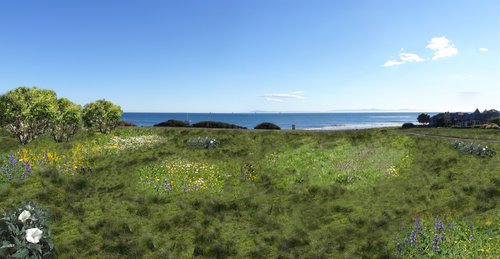About Hammonds Meadow
Hammond’s Meadow (officially “Hammond’s Meadow County Open Space”) is a Chumash heritage site known as Shalawa. The 2.96-acre parcel is located in Montecito in the Sea Meadow community, adjacent to a public beach, between Eucalyptus Lane and Channel Drive. It is owned by Santa Barbara County and managed by the County Community Services Parks Division.
hammonds Meadow project goals
Currently, the only work happening at the meadow is weed control and a limited amount of erosion control but future goals for the Hammonds Meadow project include, but are not limited to the following items proposed by Channel Islands Restoration:
Restore native habitat that supports native plants and animals.
Create a landscape that is visually pleasing and maintains views of the ocean.
Protect the integrity of the Chumash village.
Reduce erosion and vandalism that continues to degrade Chumash cultural resources.
Enhance stewardship of the site that is respectful of Chumash heritage.
Provide native plant species considered appropriate by the Chumash community.
Provide space for Chumash heritage ceremonies.
Increase sense of safety and security for the people who live by the meadow and the public that visit the beach.
Retain and enhance the public trail to the beach.
Why do we need to restore the meadow?
In addition to the goals listed above, hundreds of studies over many decades have shown that native animals (including insects etc.) thrive around native plants, and survive very poorly or disappear altogether in places where non-native plants take over. This is because native animals and plants have evolved together over millennia and depend on each other for survival. Native plants provide food, breeding and nesting habitat for the animals, and the animals most often pollinate and spread the seeds of the native plants. Non-native plants were introduced to our continent (either accidentally or deliberately) but the species that normally feed on them and keep them from utterly taking over were not. As a result, these non-native plants have become "invasive," meaning that they spread aggressively and out-compete the natives.
Nothing in biology is absolute, so there are some native animals that adapt well to non-native plants. But areas dominated by native plants almost always have higher numbers of native animals and a much higher variety of animal species than areas that are dominated by non-native plants. Some naive plants are not completely eliminated by the non-native plants, but do not fare well when forced to compete with the invasive non-native plants. At the Meadow, only two native plants have managed to survive the onslaught from the European and South-African plants that have spread in the area. One of them is "Toloache” or “Jimsonweed." Its scientific name is "Datura wrightii" and it is considered sacred by the Chumash. Each year during the rainy season it competes with non-native grasses and other weeds for light, water and nutrients. Our project is designed, in part, to reduce this competition, introduce the native plants that once grew at the meadow and give the native plants a fighting chance to grow and thrive.
When the project is completed, we envision the meadow supporting a mosaic of grasses, wildflowers and occasional low-growing shrubs, as well as oak trees in the southeastern corner of the site. Winter and spring grasses, spring wildflowers, and summer asters and golden grasses are some of the changing and appealing elements of the vegetation we hope to achieve.
The Hammond’s Meadow Preservation and Management Plan will be submitted to the County Planning & Development Department for review in early August 2017 to ensure that it is consistent with the conditions of the previous approval of the Sea Meadow development. We hope to begin implementation of the Plan as soon as the determination has been made. Click here to view the plan.



